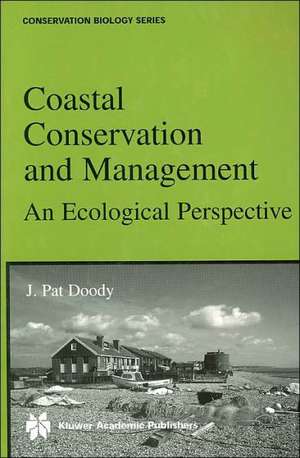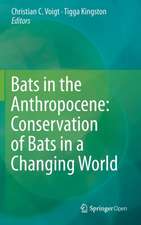Coastal Conservation and Management: An Ecological Perspective: Conservation Biology, cartea 13
Autor J. Pat Doodyen Limba Engleză Paperback – 31 oct 2002
Din seria Conservation Biology
- 11%
 Preț: 510.79 lei
Preț: 510.79 lei -
 Preț: 396.12 lei
Preț: 396.12 lei - 11%
 Preț: 474.83 lei
Preț: 474.83 lei - 18%
 Preț: 997.88 lei
Preț: 997.88 lei -
 Preț: 428.90 lei
Preț: 428.90 lei - 18%
 Preț: 957.44 lei
Preț: 957.44 lei - 11%
 Preț: 511.40 lei
Preț: 511.40 lei - 11%
 Preț: 521.80 lei
Preț: 521.80 lei - 15%
 Preț: 532.38 lei
Preț: 532.38 lei - 18%
 Preț: 1233.37 lei
Preț: 1233.37 lei - 11%
 Preț: 519.62 lei
Preț: 519.62 lei - 11%
 Preț: 482.28 lei
Preț: 482.28 lei - 11%
 Preț: 599.15 lei
Preț: 599.15 lei - 14%
 Preț: 772.46 lei
Preț: 772.46 lei - 11%
 Preț: 425.79 lei
Preț: 425.79 lei - 15%
 Preț: 644.49 lei
Preț: 644.49 lei - 11%
 Preț: 526.94 lei
Preț: 526.94 lei - 11%
 Preț: 597.21 lei
Preț: 597.21 lei -
 Preț: 383.32 lei
Preț: 383.32 lei -
 Preț: 364.04 lei
Preț: 364.04 lei - 11%
 Preț: 475.17 lei
Preț: 475.17 lei - 15%
 Preț: 646.62 lei
Preț: 646.62 lei - 11%
 Preț: 505.11 lei
Preț: 505.11 lei - 18%
 Preț: 942.94 lei
Preț: 942.94 lei - 11%
 Preț: 600.56 lei
Preț: 600.56 lei - 24%
 Preț: 1058.91 lei
Preț: 1058.91 lei - 18%
 Preț: 1240.62 lei
Preț: 1240.62 lei - 11%
 Preț: 513.79 lei
Preț: 513.79 lei -
 Preț: 459.88 lei
Preț: 459.88 lei - 18%
 Preț: 944.36 lei
Preț: 944.36 lei - 24%
 Preț: 790.95 lei
Preț: 790.95 lei - 11%
 Preț: 567.97 lei
Preț: 567.97 lei
Preț: 948.92 lei
Preț vechi: 1157.22 lei
-18% Nou
Puncte Express: 1423
Preț estimativ în valută:
181.58€ • 189.97$ • 150.84£
181.58€ • 189.97$ • 150.84£
Carte tipărită la comandă
Livrare economică 02-16 aprilie
Preluare comenzi: 021 569.72.76
Specificații
ISBN-13: 9781402072482
ISBN-10: 1402072481
Pagini: 332
Ilustrații: XX, 308 p.
Dimensiuni: 155 x 235 x 17 mm
Greutate: 0.54 kg
Ediția:Softcover reprint of the original 1st ed. 2001
Editura: SPRINGER NETHERLANDS
Colecția Springer
Seria Conservation Biology
Locul publicării:Dordrecht, Netherlands
ISBN-10: 1402072481
Pagini: 332
Ilustrații: XX, 308 p.
Dimensiuni: 155 x 235 x 17 mm
Greutate: 0.54 kg
Ediția:Softcover reprint of the original 1st ed. 2001
Editura: SPRINGER NETHERLANDS
Colecția Springer
Seria Conservation Biology
Locul publicării:Dordrecht, Netherlands
Public țintă
ResearchCuprins
1. INTRODUCTION.- 1.1 Scope of the Book.- 1.2. Early Human Occupation.- 1.3Natural or Man-Made?.- 1.4 Defining the Coastal Zone.- 1.5 Coastal Landscapes.- 2. General Principles.- 2.1 Origins of Coastal Conservation.- 2.2 Coastal Management.- 3. Sea Cliffs &Amp; Sea Cliff Vegetation.- 3.1 Introduction and Scope.- 3.2 Habitat Distribution.- 3.3 Nature Conservation Value.- 3.4 Plant Communities Ȅ Regional Variation in Europe.- 3.5 Invertebrates.- 3.6 Human Activities and Conservation.- 3.7 Grazing.- 3.8 Recreation.- 3.9 Other Management Issues.- 3.10 Conservation and Coast Protection.- 4. SEABIRDS, SEA CLIFFS & ISLANDS.- 4.1 Introduction.- 4.2 Seabird Locations and Habitat.- 4.3 Seabird Conservation and Human Activities.- 4.4 Cumulative Interactions.- 5. Saltmarsh.- 5.1 Introduction and Scope.- 5.2 Habitat Distribution.- 5.3 Nature Conservation Value.- 5.4 Human Activities and Conservation.- 5.5 Historical Losses and Sea Level Change.- 5.6 Grazing on Saltmarsh.- 5.7 Other Management Issues.- 5.8 Recreation And Access.- 5.9 Pollution.- 5.10 Complex Relationships.- 5.11 Sea Defence, Sea Level Rise and Saltmarshes.- 6. Spartina Anglica — A Case of Invasion.- 6.1 Origins and Colonisation.- 6.2 Nature Conservation Implications.- 6.3 Spartina in the Usa.- 6.4 Methods of Management.- 6.5 Spartina Friend or Foe?.- 6.6 Is There a Case for Control?.- 7. Sand Dune.- 7.1 Introduction and Scope.- 7.2 Sand Dune Distribution.- 7.3 Nature Conservation Value.- 7.4 Human Activities And Conservation.- 7.5. The Importance Of Grazing.- 7.6 Dune Hydrology.- 7.7 Golf Courses.- 7.8 Sand Dunes, Climate Change And Sea Level Rise.- 8. Shingle Beaches & Structures.- 8.1 Introduction And Scope.- 8.2 Habitat Distribution.- 8.3 Nature Conservation Value.- 8.4 Human Activities and Conservation.- 8.5 Options and Opportunities.- 9. Nature Conservation at Dungeness — A Case History.- 9.1 Introduction.- 9.2 Evolution Of Dungeness.- 9.3 Nature Conservation Importance.- 9.4 Human Activity and Conservation.- 10. Coastal Wetlands — Estuaries, Deltas & Lagoons.- 10.1 Introduction and Scope.- 10.2 Habitat Distribution.- 10.3 Nature Conservation Value.- 10.4 Species Distribution within an Estuary.- 10.4.1 Human Activities and Conservation.- 10.5 The ‘Estuary Squeeze’.- 10.6 Coastal Defence.- 10.7 Pollution.- 10.8 Time-Scales for Change.- 11. Grazing Marshes &Amp; Salinas.- 11.1 Introduction and Scope.- 11.2 Grazing Marsh (Coastal Wet Grassland).- 11.3 Habitat Distribution.- 11.4 Nature Conservation Value.- 11.5 Human Activities And Conservation.- 11.6 Management.- 11.7 Sea Defence.- 11.8 Salinas As Secondary Habitats?.- 11.9 Management.- 11.10 Fish-Farms And Rice Fields.- 12. Ecological Networks.- 12.1 Introduction And Scope.- 12.2 The Nature Of Coastal Networks.- 12.3 Networks, Some Examples.- 12.4 Geographical Scales.- 12.5 The Red Knot, Land Claim and Sea Level Rise.- 12.6 International Protection and Local Management.- 13. Integrated Coastal Management.- 13.1 Introduction.- 13.2 Defining the Coastal Zone.- 13.3 Coastal Management.- 13.4 International / National Policy.- 13.5 The European Union Demonstration Programme.- 13.6 European Governmental Approaches.- 13.7 Other Institutional Methods.- 13.8 Local Initiatives; Raising Awareness and Promoting Understanding, The Role of Research.- 13.9 Implementing Integrated Coastal Management.- 14. Habitat Protection, Coastal Conservation & Management.- 14.1 Introduction.- 14.2 The Coastal ‘Squeeze’ — A New Paradigm?.- 14.3 Sea Level Change.- 14.4 Changing Attitudes — Dynamic Conservation?.- 14.5Integrating Management.- 14.6 Participation And Consultation.- 14.7 The Future.- 14.8 “Win Some, Lose Some”.- References.- English Names of Commoner Plants.












